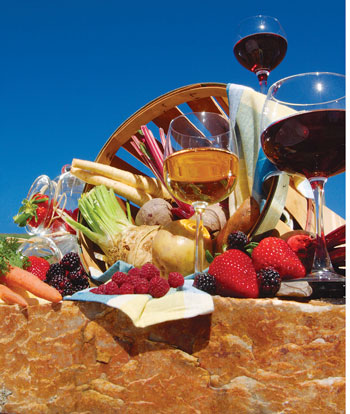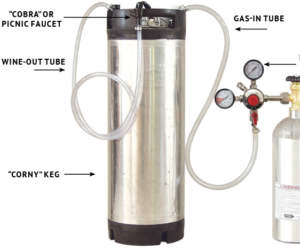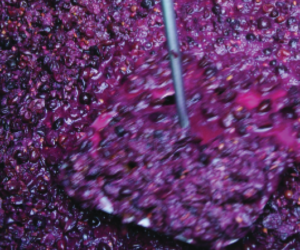
These wines are not common in the commercial marketplace where dry grape wines dominate. There are some fruit wines, of course, and a few novelty wines made with coffee or chocolate. You can find mulled or spiced holiday wines to serve warm in the winter. Among the small group of wines known as aperitifs or digestifs, most contain spices or herbs and a few include vegetable ingredients. But you probably won’t see a shelf at your local bottle shop with a sign that looks like the title of today’s column. Don’t let that put you off: You are a home winemaker and you can do whatever you want. Here are some basic guidelines for exploring homemade wines with spices, herbs, and vegetables.
I have made a few wines like this, but wanted to check how widely they appear in home winemaking. At the store where I used to be an owner, The Beverage People in Santa Rosa, California, they sell a little purple book called Winemaker’s Recipe Handbook by Raymond Massaccesi. A remarkable compendium of wine ideas, it includes instructions for using fresh grapes, grape juice, and grape concentrate. Massaccesi goes far beyond those limits, though, with recipes for wines made with produce like root vegetables, including beets, carrots, onions, potatoes, parsnips, and turnips. He includes concepts and details for incorporating coffee or tea. Other foods that are typically considered vegetables in the kitchen are also included; like corn, pumpkin, rhubarb, and tomatoes. Even plants that are not often found on the kitchen table get some attention, like rose hips and dandelion blossoms. So the sky’s the limit — if it’s edible and you want to make wine out of it, give it a try.
Most of these non-fruit wines do not get significant sugar from the flavoring ingredients. You need enough sugar to get enough alcohol to make your beverage taste like wine and be shelf stable. That usually means a minimum of about 9% alcohol by volume (ABV) and no more than about 16% for direct fermentation (so the yeast will survive to finish) or about 20% if fortified. For 9% ABV you need a starting sugar level of about 16° Brix (percent sugar by weight) and for 16% ABV you need about 29° Brix. Most of these adult beverages use some other source for sugar, with the spices, herbs, and vegetables (SHV) providing aromas, flavors, and mouthfeel.
You need enough sugar to get enough alcohol to make your beverage taste like wine and be shelf stable.
Beverages like these are much more common among beers and meads. In beers, barley malt or sugars derived from other grains provide the base for alcoholic fermentation. Go to your local craft brewery and you are very likely to encounter something like a chocolate porter, a coffee stout, or even a rhubarb gose (with or without strawberries or apples). As a certified beer judge, I have often judged the “spice, herb, vegetable beers” category and have brewed a few such beers myself. A few years ago, Bear Republic Brewing of Healdsburg, California selected my Marie Laveau III black pepper Pilsner to brew as a pro-am entry for the Great American Beer Festival. We didn’t win, but the beer was well received on tap at the brewpub and I think black pepper might enhance a tasty Chenin Blanc or Sauvignon Blanc wine.
Among meads, where honey provides the carbon source for alcohol production, herbs and spices have such a prominent history that the category even has its own name, metheglin. My onetime fermentation mentor, the late Byron Burch, achieved considerable renown in meadmaking circles with his Sweetness of the Holy Fire mead made with lime juice and chile de arbol. Meads are often flavored with ginger, teas, or citrus peel — wines can be, too.
As a wine project, you will usually look at either adding flavor to a basic wine or building a flavored wine from the start. For additions of flavors to a wine you already made, the use of homemade extracts can be very effective. That is the approach I used to make fortified aperitifs for an article found in the December ’18-January ’19 issue (available at https://winemakermag.com/article/aperitifs). For a sweet vermouth, I made an alcoholic extract of spices, herbs, and citrus peel for addition to homemade Pinot Noir. For a cranberry Viognier aperitif, I extracted fruit (the cranberries) along with two kinds of dried citrus peels. Adding the extracts both flavored and fortified the wines. You can use this method for just about any flavoring (and, indeed, it’s what Burch did for the chilies in his mead). You will get some increase in alcohol from adding the extract, so look at my article or a good winemaking book for instructions on using Pearson’s Square to calculate the outcome. Then soak your choice of SHV in vodka or other strong spirits for anywhere from one day to a week or so. Strain the extract and add to the wine to taste. If sugar is involved, you should stabilize with potassium sorbate. If not using your flavored wine right away be sure to add sulfite.
The other approach is building the wine from scratch. If you start with fresh grapes or grape juice, you may want to ferment it directly at the sugar level as received. For grape concentrate or other sugar sources, you will need to do some calculations. To reach a common table wine alcohol level of 12% ABV, you will need a starting Brix of about 22. I make this estimate using a factor that has worked well for me in the past: 0.55 x starting Brix ~= ABV of the wine. So, 22 x .55 = 12.1%. How to get that sugar level depends on your sugar source. Calculated for each gallon (3.8 L) of prepared must at 22° Brix, use the following estimates. Dissolve the sugar or syrup in less than a gallon of clean, odor-free water and then dilute to one gallon.
Most commonly, you will need additions of acid, nutrients, and possibly tannins.
After you prepare the desired volume of sugar water for your project, you will need to make some further adjustments to produce a beverage that tastes more-or-less like wine and that supports a healthy yeast fermentation. Most commonly, you will need additions of acid, nutrients, and possibly tannins. Some spices will bring additional tannic character to your wine on their own, so you may want to minimize grape tannin addition. These include “woody” spices like cinnamon, nutmeg, and allspice as well as coffee and tea. Other herbs or spices may add tartness, leading you to reduce your acid addition. These may include lemon or orange peel, lemon verbena, and rhubarb, among others. Think about your flavor profile, then make your adjustment. If you are anticipating neither acid nor tannin from your SHV addition, here are some reasonable starting levels:
Tartaric acid: add 6 grams per liter (0.8 oz. per gallon)
Grape tannin: add 0.1 gram per liter (0.4 g per gallon/0.014 oz. per gallon)
Many home winemaking books recommend acid blend instead of tartaric acid in country wines. I favor pure tartaric acid because it resists microbial degradation. Bacteria can metabolize the other two common “blend” components, citric and malic acid. So a tartaric addition is potentially more stable. If the wine is to be consumed young, the choice of acid additions should be determined more by the flavor component added rather than stability of the acid though. Citric acid may be more appropriate depending on the blend of ingredients, with the same being true of malic acid and acid blend.
For adding your SHV ingredients, I like to do this kind of fermentation in a loosely covered food-grade bucket. I put the SHV ingredient(s) in a nylon mesh bag (previously boiled for sanitation) and place the bag in the juice or sugar water in the bucket. For hard vegetables like carrots or pumpkins, you can cube the food, place it in the nylon bag, and boil it in the water you will use for the wine until the vegetable is soft. Put your sugar in the bucket, add the cooled water from the boil, and put in the bag of vegetable pulp. Add 1 crushed Campden tablet per gallon or about 50 mg/L of sulfite. Let stand loosely covered overnight for sulfite to dissipate.

Add yeast at a rate of 1 g/gallon (263 mg/L). You can use a neutral yeast to show off the SHV, or an estery yeast to enhance fruitiness. You should also add a yeast nutrient, since your sugar must is very low in nitrogen. A good mid-range value is to add a complete nutrient blend like Fermaid O or Superfood at about 1⁄2 g/gallon (132 mg/L) at the start of fermentation and another 1⁄2 g/gallon (132 mg/L) at about 1⁄3 of your fermentation. Punch down or stir with a sanitized spoon twice a day. Spoon out some fermenting must and taste after about three days. If your SHV flavor is strong enough, remove the bag. Otherwise, leave it in until primary fermentation is complete, squeeze the bag, and rack your flavored wine into a topped-up jug or carboy for further clarification and aging. Fine or filter as needed.
One final note is the recognition that some of what we call “vegetables” are actually fruits and may contribute some sugar to the fermentation. One autumn as I was beginning to measure Brix in my vineyard, I also measured the Brix of a ripe, homegrown tomato. It came in at 8 °Brix! Not enough for wine on its own, but enough to contribute to the total. I used an estimate that the Brix measurement would represent extractable materials from the tomatoes—juice and whatever maceration I could get in fermentation. I decided to use 8 lbs. (3.6 kg) of tomatoes in 3 gallons (11.4 L) of sugar must. If the extractable part is about half the total (as it is with grapes), that means I added 4 lbs. (1.8 kg) of tomato extract at 8 °Brix to my 3-gallon (11.4-L) must while the fruit macerated during fermentation. If I added no fruit, my chart on page 52 shows I would need 6 lbs. (2.7 kg) of corn sugar in 3 gallons (11.4 L) for 22 °Brix. Instead, my tomatoes would yield something like 4 lbs. (1.8 kg) x 0.08 = 0.32 lb. (145 g) of sugar. (The 0.08 is 8% expressed as a decimal; Brix is percent sugar by weight.) So I could subtract 0.32 lb. (135 g) from my 6 lbs. (2.7 kg) and just add 5.7 lbs. (2.6 kg) instead. It is not a big difference, and probably wouldn’t matter much, but it is worth checking to make sure if you use a sugar-containing vegetable in your next SHV wine.







